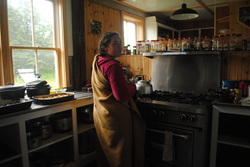
Hello! My name is Christine Walder, and I'm on Kent Island for the summer doing research in the intertidal zone. I'll be starting my Junior year at Bowdoin in the fall, where I'm a Biology and Environmental Studies coordinate major. Some fun facts: my favorite intertidal creature is a red-gilled nudibranch, I ate a periwinkle yesterday (it was surprisingly not bad), and I haven't used the shower yet! Don't worry though, I go swimming and take bucket showers pretty regularly.
The intertidal zone at Kent Island is amazing, and I absolutely love it! At about 30 feet, the Bay of Fundy has the largest tides in the world. The intertidal zone here stretches out almost a quarter of a mile in some places, and is dominated by rockweed-covered bedrock. Tidepools ranging from bucket-sized to swimming-pool sized are peppered across the intertidal, and underwater are a whole host of beautiful and unique creatures--ballerina pink coralline seaweed, delicate anemones, kelp, giant periwinkles, whelks, etc. There can be hundreds of snails, mussels, and crabs within just a few square meters.
I'm working on a rockweed harvesting project. Ascophyllum nodosum, the dominant algal species from Maine up into Canada, is a rope-like olive green seaweed that is central to much of the life found in the intertidal. It's essentially the old-growth forest of the sea, forming a floating seaweed jungle that provides shelter and alters water flow during high tide. When the tide is out, it insulates organisms from extreme temperature fluctuations and dessication. Removing too much rockweed could seriously affect its ability to perform these functions. Current rockweed harvesting protocols are based on the seaweed's ability to regenerate, rather than the ecosystem's ability as a whole to withstand its repeated removal. Because of this, I'm working to set up a long-term monitoring site to look at the effect of rockweed harvesting on ecosystem health.
I've set up 15 sites, each consisting of a control plot and an experimental plot. I surveyed each one (it involves counting a lot of snails among other things), harvested the experimental plots, and then surveyed them again. I'll be starting a third round of surveys right before we leave, but right now I'm making the plots permanent so they can be found next year. Which is actually quite challenging, since everything in the intertidal always seems to be moving around.
My stay at Kent Island has been absolutely incredible, and I love it here. Time is flying by, and I can't believe we're all leaving in a few weeks. I'll miss all the glorious sunsets, and who knows, I might even miss the gulls! Not until I wash the latest splatter off my clothes, though.
The intertidal zone at Kent Island is amazing, and I absolutely love it! At about 30 feet, the Bay of Fundy has the largest tides in the world. The intertidal zone here stretches out almost a quarter of a mile in some places, and is dominated by rockweed-covered bedrock. Tidepools ranging from bucket-sized to swimming-pool sized are peppered across the intertidal, and underwater are a whole host of beautiful and unique creatures--ballerina pink coralline seaweed, delicate anemones, kelp, giant periwinkles, whelks, etc. There can be hundreds of snails, mussels, and crabs within just a few square meters.
I'm working on a rockweed harvesting project. Ascophyllum nodosum, the dominant algal species from Maine up into Canada, is a rope-like olive green seaweed that is central to much of the life found in the intertidal. It's essentially the old-growth forest of the sea, forming a floating seaweed jungle that provides shelter and alters water flow during high tide. When the tide is out, it insulates organisms from extreme temperature fluctuations and dessication. Removing too much rockweed could seriously affect its ability to perform these functions. Current rockweed harvesting protocols are based on the seaweed's ability to regenerate, rather than the ecosystem's ability as a whole to withstand its repeated removal. Because of this, I'm working to set up a long-term monitoring site to look at the effect of rockweed harvesting on ecosystem health.
I've set up 15 sites, each consisting of a control plot and an experimental plot. I surveyed each one (it involves counting a lot of snails among other things), harvested the experimental plots, and then surveyed them again. I'll be starting a third round of surveys right before we leave, but right now I'm making the plots permanent so they can be found next year. Which is actually quite challenging, since everything in the intertidal always seems to be moving around.
My stay at Kent Island has been absolutely incredible, and I love it here. Time is flying by, and I can't believe we're all leaving in a few weeks. I'll miss all the glorious sunsets, and who knows, I might even miss the gulls! Not until I wash the latest splatter off my clothes, though.
 RSS Feed
RSS Feed